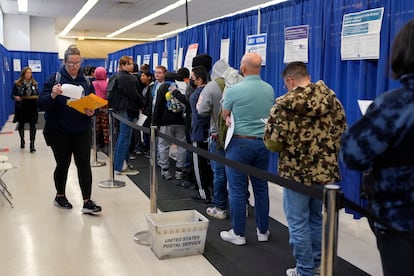Early voting shows strong Republican mobilization in swing states
A total of 42 million US voters have already cast their ballot. This represents 27% of the 155 million people who participated in the 2020 election


The campaign is in its final stages. Both Donald Trump and Kamala Harris are set to tour key swing states where the election outcome will likely be decided. However, for 42 million Americans, the choice has already been made: they’ve cast their ballots, either in person or by mail, through the early voting options provided by their states. This figure is lower than in 2020, which saw record early voting due to the pandemic.
Current data show strong early turnout among Republican-registered voters, especially in swing states, though it’s unclear what this signals for the final result. Unlike in 2020, when Trump and the Republicans cast doubts about mail-in voting and urged supporters to vote in person on Election Day, this time they are actively promoting early voting.
In the United States, each state organizes its voting process independently, guided by the minimum requirements set by federal law. The rules and timelines for mail-in and in-person early voting vary, as do regulations around voter registration, identification, ballot formats, and counting methods. Some states make registration and voting straightforward, while others are poorly organized, often resulting in long lines. The information states release about early voting also varies; some provide data on party affiliation — Republican, Democrat, or independent — while others do not. Similarly, certain states report data on voters’ age, gender, and race, though most do not disclose this information. As a result, the overall picture remains blurry.
According to the latest data compiled by the University of Florida’s Election Lab, 42 million Americans have voted early. This represents 27% of the 155 million U.S. voters who participated in the 2020 election, though the figure is still significantly lower than the number who voted four years ago at the same point in the election cycle.
So far, 21.1 million citizens have cast their votes in person at designated polling stations, while another 21.3 million votes have been submitted by mail — a method that has been requested by over 65 million people. These early voting figures are the second highest in history. In 2020, the pandemic led to unprecedented levels of early voting, as states implemented measures to minimize the risk of contagion — many of which remain in place today. Approximately 70% of votes in that election were cast early or by mail.

In the overall count, registered Democrats are currently leading with 8.4 million ballots, representing 40% of those identified. However, their lead over Republicans has narrowed significantly compared to 2020, with Republicans casting 7.6 million ballots, or 36% of the total. Additionally, 4.8 million citizens — 24% of the total — have identified as independents, either not registered with any party or affiliated with minor parties. It’s important to note that being registered with a party does not guarantee that a voter will support that party. Moreover, data on over 20 million voters is unavailable because they voted in states that do not disclose party affiliation.
While early voting has declined nationwide, it remains close to or exceeds levels seen four years ago in the seven battleground states. This is where Republicans are particularly ramping up their mobilization compared to 2020. During the last election cycle, Trump promoted conspiracy theories about mail-in voting being rigged and urged voters to cast their ballots on Election Day. This year, however, he is both celebrating and encouraging early voting, albeit not consistently.
“We’re setting all-time records with the votes. The early voting is records [sic]. The Trump people are coming out, they’re voting like crazy. And, typically, we get our big voting at the end,” the former president said Friday at a rally in Traverse City, Michigan. “It will be the single greatest political victory in the history of our country.”
Of the seven swing states, three do not make it easy for voters to register their political affiliation: Georgia, where turnout has been record-breaking, Michigan, and Wisconsin. In North Carolina, Arizona and Nevada, Republicans are in the lead — unlike in 2020. And in Pennsylvania, the Democratic lead is significantly smaller than what it was in 2020.
In North Carolina, where records are being set despite logistical challenges related to Hurricane Helene recovery efforts, Republicans have cast 940,000 ballots (34.3%), while Democrats have cast 910,000 (33.2%), and independents 891,000. In 2020, Trump won North Carolina by just 1.3 points, even though Democrats had a 15-point lead in early voting at this stage.
Arizona shows an even more pronounced trend. Current figures indicate 542,000 Republican votes (42%), compared to 454,000 Democratic votes (35%) and 297,000 independents (23%). This marks a significant contrast to the 10-point lead Democrats enjoyed at this point in 2020, when Joe Biden won Arizona by a mere 10,457 votes.
A similar trend is emerging in Nevada, where Republicans have erased the Democrats’ previous advantage of over 10 points and are now leading by five points. Currently, 244,000 Republicans have cast their votes (40%), compared to 213,000 Democrats (35%) and 155,000 independents (25%). In 2020, Biden won the state by 2.4 points.
In Pennsylvania, however, Democrats maintain a clear lead, benefiting from a system that relies solely on mail-in voting, as there is no in-person early voting. This method, which was heavily criticized by Republicans in the past, is now being pushed by the party. Of the ballots received in this crucial state, 762,000 (59.4%) are from registered Democrats, while 390,000 (30.4%) are from Republicans and 130,000 (10.2%) are from independents.
While this may appear to be a success for Democrats, it’s worth noting that in 2020, they had a similar margin on Election Day, with a breakdown of approximately 70%-20% in their favor. Ultimately, Biden won Pennsylvania by just one point after all ballots were counted. This year, the counting process may be somewhat speedier than in 2020, when mail-in ballots were accepted up to three days after Election Day. This time, the deadline is 8 p.m. on November 5.
The rise in early voting among Republicans, along with Trump’s improved standing in polls and betting markets, as well as favorable trends in Treasury bonds and the dollar, appears to slightly tilt the balance in favor of the former president. However, the distortions caused by Covid-19 four years ago and the 180-degree shift in Republican leadership regarding early voting mean these figures should be analyzed with caution. Counting, including counting of early votes, will not commence until Election Day, and it is then, or in the subsequent days, that the winner will be determined.
Sign up for our weekly newsletter to get more English-language news coverage from EL PAÍS USA Edition
Tu suscripción se está usando en otro dispositivo
¿Quieres añadir otro usuario a tu suscripción?
Si continúas leyendo en este dispositivo, no se podrá leer en el otro.
FlechaTu suscripción se está usando en otro dispositivo y solo puedes acceder a EL PAÍS desde un dispositivo a la vez.
Si quieres compartir tu cuenta, cambia tu suscripción a la modalidad Premium, así podrás añadir otro usuario. Cada uno accederá con su propia cuenta de email, lo que os permitirá personalizar vuestra experiencia en EL PAÍS.
¿Tienes una suscripción de empresa? Accede aquí para contratar más cuentas.
En el caso de no saber quién está usando tu cuenta, te recomendamos cambiar tu contraseña aquí.
Si decides continuar compartiendo tu cuenta, este mensaje se mostrará en tu dispositivo y en el de la otra persona que está usando tu cuenta de forma indefinida, afectando a tu experiencia de lectura. Puedes consultar aquí los términos y condiciones de la suscripción digital.
More information
Archived In
Últimas noticias
Most viewed
- Sinaloa Cartel war is taking its toll on Los Chapitos
- Oona Chaplin: ‘I told James Cameron that I was living in a treehouse and starting a permaculture project with a friend’
- Reinhard Genzel, Nobel laureate in physics: ‘One-minute videos will never give you the truth’
- Why the price of coffee has skyrocketed: from Brazilian plantations to specialty coffee houses
- Silver prices are going crazy: This is what’s fueling the rally










































